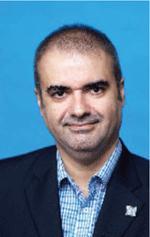Earthquake risk management for oil and gas infrastructure in the north west of Australia
Meysam Banimahd A B , Steve Tyler A , Matthew Kuo A and Fiona Chow AA Woodside Energy Ltd, Mia Yellagonga, 11 Mount Street, Perth WA 6000, Australia.
B Corresponding author. Email: Meysam.banimahd@woodside.com.au
The APPEA Journal 60(2) 588-594 https://doi.org/10.1071/AJ19213
Accepted: 24 February 2020 Published: 15 May 2020
Abstract
The July 2019 magnitude 6.6 earthquake 200 km offshore from Broome is a recent reminder of the significant risk that earthquakes pose to oil and gas infrastructure in Australia. Unlike tropical cyclones, there are no reliable methods for predicting the timing, location and magnitude of imminent earthquakes. Appropriate risk management is therefore required, together with the implementation of emergency response and integrity management procedures, to manage the potential impacts to health, safety, process safety, the environment and production. Given the concentration of oil and gas infrastructure in the north west of Australia, a collaborative approach is advantageous for earthquake risk management and emergency response measures. This paper shares Woodside’s earthquake risk and integrity management procedures with the aim of enabling appropriate quality and consistency throughout the industry. The paper reviews state-of-the-art international practice in earthquake risk management for critical infrastructure from design to operation. Applicable seismic design criteria, likely failure modes and performance requirements are also described. Woodside’s real-time earthquake alert and integrity management systems are presented. Recommendations are made on best practice for earthquake risk management in the region and areas for further collaboration and improvement within the industry.
Keywords: earthquake alert system, earthquake risk management, emergency management, seismic design, technical integrity.

Meysam Banimahd is a Chartered Engineer with 19 years of experience in energy and infrastructure sectors in Iran, Germany, UK and Australia. After completing his PhD in Computational Geodynamics at Heriot Watt University in Edinburgh, Meysam worked for the offshore engineering division of Technip UK. He moved to Australia to join Woodside in January 2012. At Woodside, as a Chief Geotechnical Engineer, a Technical Authority and an Engineering Lead, he provides technical assurance, engineering and risk management support for multidisciplinary projects and developments. Meysam is actively involved with national and international standard committees and has been a recipient of multiple industry awards including the 2008 Webb Prize from UK’s Institution of Civil Engineers. |

Steve Tyler currently holds the position of Principal Geophysicist and Engineering Geohazard Specialist at Woodside Energy Ltd. He is currently responsible for advising development project teams on geohazard risk, scoping and execution of geophysical and geotechnical acquisition, as well as conducting geohazard assessments and providing interpretation and detailed integration of geoscience data for ground model development. He has considerable experience working worldwide on oil and gas, cable route and infrastructure projects onshore and offshore including all of the major North West Shelf projects in Australia and across Woodside’s global project portfolio. He also has considerable offshore management and survey execution experience having held the position of Party Chief for many years and spent over 10 years on diverse offshore projects around the globe. He holds a PhD in Marine Geology and Geophysics and completed a research scholarship at Woods Hole Oceanographic Institute involving the analysis of marine geophysics and other multidisciplinary data within a GIS environment. He is a member of ISO Panel (TP2 - Geophysical Site Investigation) and the Australian Standards Review Panel. |

Matthew Kuo is a Senior Geotechnical Engineer at Woodside with over 14 years of experience in onshore and offshore infrastructure for both the oil and gas and renewable energy sectors. He holds a BSc/BE double major in Geology and Civil Engineering (Hons) from the University of Western Australia and a PhD from Cambridge University. Before joining Woodside, Matthew worked at Worley in Australia and Cathie Associates in Belgium, and held the position of Sharjah Fellow in Petroleum Resources at Cambridge University. Matthew currently serves on the SUT OSIG Perth committee. |

Fiona Chow is Civil Structural Engineering Manager at Woodside Energy. Graduating from Cambridge University and with an MSc and a PhD from Imperial College, Fiona has worked with Arup Geotechnics, the Geotechnical Consulting Group and Worley. She is a Chartered Engineer, Fellow of Engineers Australia, Adjunct Professor at the University of Western Australia and member of the ISO/API Committee for Offshore Foundations. |
References
Chen, J.-Y., Chen, C.-H., Ku, A., and Sheppard, R. (2017). A practical and interdisciplinary framework to develop post-earthquake evacuation and inspection thresholds for offshore platforms. In ‘Offshore Technology Conference, 1–4 May, Houston, Texas’. Offshore Technology Conference.International Atomic Energy Agency (2011). ‘Earthquake preparedness and response for nuclear power plants, Safety Reports Series No. 66.’(IAEA: Vienna.)
ISO (2017) ISO 19901–2:2017 Petroleum and natural gas industries – Specific requirements for offshore structures – Part 2: Seismic design procedures and criteria. (International Organization for Standardization)
NOPSEMA (2019). Consideration of risks from earthquake events. The Regulator Issue 3. pp. 13–14. Available at https://www.nopsema.gov.au/assets/Publications/A696715.pdf [verified 3 March 2020]
Standards Australia (2007) AS1170.4–2007. Australian Standard. Structural Design Actions Part 4: Earthquake actions in Australia. (Standards Australia)
United States Geological Survey (2003). Monitoring earthquake shaking in buildings to reduce loss of life and property, USGS Fact Sheet 068–03. (USGS.)


